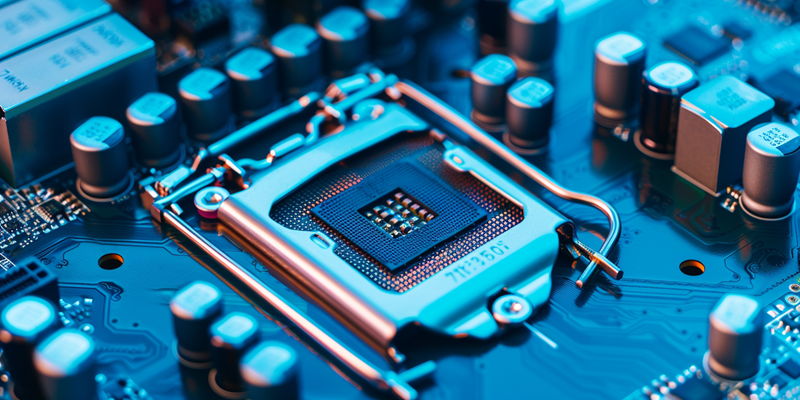As the next-generation Ryzen 9000X3D processors from AMD approach their release, speculation and anticipation abound in the tech community. Much of the excitement centers around whether AMD will allow full manual overclocking for these cutting-edge processors, marking a departure from the company’s previous restrictive policies regarding 3D V-Cache technology. Historically, AMD’s use of 3D V-Cache has limited overclocking capabilities due to the technology’s heightened sensitivity to voltage changes. However, recent reports hint that AMD might be ready to grant enthusiasts and gamers unprecedented control over their systems by allowing full manual overclocking in the forthcoming Ryzen 9000X3D processors.
In the past, AMD has taken a cautious approach with its 3D V-Cache technology. The first-generation Ryzen 5000X3D processors outright prohibited any type of overclocking, leaving users with no room for manual adjustments. It wasn’t until the Ryzen 7000X3D series that AMD began to loosen its grip slightly, allowing limited overclocking through Precision Boost Overdrive (PBO). PBO offers a minor, automated overclock, thereby enabling small performance tweaks without requiring user intervention. Now, rumors suggest that AMD might be ready to make another leap forward by unlocking full manual overclocking for the upcoming Ryzen 9000X3D processors, a move that would provide enthusiasts the freedom to directly adjust voltages within safety limits.
Potential Shifts in Overclocking Capabilities
If AMD indeed decides to unlock full manual overclocking for the Ryzen 9000X3D processors, this policy change would signal a significant milestone for the company. It suggests that AMD has refined its 3D V-Cache technology to withstand higher levels of stress, granting users more flexibility in harnessing the full potential of their processors. This potential shift would cater specifically to enthusiast gamers seeking maximum performance, assuming they employ adequate cooling solutions to manage the increased thermal output. By enabling manual overclocking, AMD would not only provide users with greater control over their systems but also potentially unlock even greater performance gains, further enhancing the gaming experience.
In the broader competitive landscape, AMD’s move could increase pressure on Intel, which is also gearing up to release its next-generation Arrow Lake processors. Historically, Intel has maintained an edge in manual overclocking capabilities, but AMD’s potential policy change could level the playing field. The timing of AMD’s new Ryzen 9000 series might also play a crucial role, as these processors are expected to hit the market before Intel’s Arrow Lake lineup. Full manual overclocking would undoubtedly excite the gaming community and could force Intel to accelerate its own advancements in response to AMD’s bold move.
A Continued Evolution in Processor Technology
The overarching trend in AMD’s processor development has been one of progressive improvement in overclocking capabilities with each new generation. Moving from absolutely no overclocking in the first generation of 3D V-Cache to the possibility of full manual control in the third, AMD seems committed to balancing innovation with user empowerment. This consistent enhancement in overclocking options reflects AMD’s strategy to cater to tech enthusiasts who seek the ultimate performance from their systems. The company appears to be refining its technology while ensuring that safeguards are in place to protect the delicate 3D V-Cache from potential damage due to voltage irregularities.
Beyond satisfying the demands of gamers and tech enthusiasts, AMD’s possible policy shift towards full manual overclocking demonstrates a broader confidence in their technology. By allowing users to push their systems to the limits, AMD is setting a new standard for processor performance and control. This move points to a future where users have unprecedented flexibility to tweak their systems according to their specific needs and preferences, all while maintaining system stability through built-in safety measures.
Implications for the Competitive CPU Market
As AMD’s next-generation Ryzen 9000X3D processors near their release, the tech community is buzzing with speculation and anticipation. A significant point of excitement is whether AMD will permit full manual overclocking for these advanced processors, breaking from its traditionally restrictive stance on 3D V-Cache technology. Historically, this technology’s sensitivity to voltage changes has limited overclocking abilities. However, there are hints that AMD might grant unprecedented control to enthusiasts and gamers by allowing manual overclocking in the upcoming Ryzen 9000X3D processors.
In the past, AMD has been cautious with its 3D V-Cache. The Ryzen 5000X3D processors completely blocked any kind of overclocking, offering no scope for manual adjustments. This stance began to shift slightly with the Ryzen 7000X3D series, which allowed limited overclocking through Precision Boost Overdrive (PBO). PBO provides a minor, automated overclock, enabling modest performance tweaks without user intervention. Now, rumors suggest AMD might take a significant leap by unlocking full manual overclocking for the new Ryzen 9000X3D processors, giving enthusiasts the freedom to directly adjust voltage settings within safe limits.

